




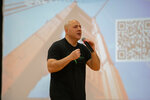
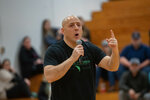
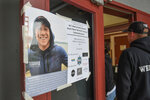
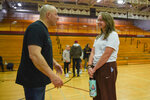






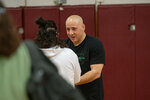







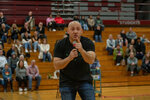
The moment Kevin Hines jumped from the Golden Gate Bridge on Sept. 25, 2000, he regretted it.
As he fell 25 stories to the chilly San Francisco Bay, he prayed he would miraculously be one of the few who lived. Since its completion in 1937, an estimated 2,000 people have taken their own lives at the bridge, an average of about two people a month, while only 36 who have jumped from the iconic bridge survived.
As he hit the water, the 15,000 pounds of pressure on Hines' body shattered three vertebrae and nearly severed his spinal cord, injuries that still leave him in pain more than 20 years later.
“I wish I knew back then what I know today. When I lept off of that bridge, I wish I knew that my thoughts did not have to become my actions if they were dangerous to myself or others,” Hines said.
As he hit the water, the suicidal thoughts and ideations that plagued Hines were replaced by survival mode, as he frantically swam in an attempt to keep his head above the water line. As his head ducked below the water, he struggled to make it to the surface.
“My boots are waterlogged. My long-sleeved clothing is heavy,” Hines said. “I think to myself, ‘This is it. This is where I go. No one is coming to save me. I’m going to die here.’”
Facing near-certain death as he treaded water, a sea lion, whom Hines nicknamed Herbert, buoyed Hines’ body until a Coast Guard boat arrived to pull him from the water.
“You can call that whatever you want. That is my personal miracle,” Hines said of the sea lion. “And I will always, and forever, believe that is what saved my life that day.”
More than two decades later, Hines found himself in the W.F. High School gymnasium Thursday night, one of the 36 people who survived a fall from the bridge. An advocate for mental health and suicide prevention, Hines was featured in the 2006 film “The Bridge” by Eric Steel.
Abby Alexander, a W.F. West High School senior who helped organize the event, said she was inspired to help organize the speech after she saw an increase in students struggling with their mental health, particularly after the pandemic.
“I think it was important for me to do something from a student perspective, also, because adults can do and say so much, but a lot of kids aren’t going to listen,” Alexander said. “A lot of kids who are really struggling want to hear from someone who is their age, or who knows what they are going through.”
The community presentation was sponsored by the Drew North Foundation, founded by Steve and Jennie Douglass, of Chehalis, after their son, Drew, died by suicide. In the years since, the foundation has raised funds for youth mental health resources.
“We’re super proud of Abby. She took this on. She had a vision,” Jennie said Thursday. “To me, that’s the most impactful because it is within the students that they’re feeling this need.”
Donors who helped make Hines’ visit possible also included Northwest Pediatrics, Dr. Jennifer Scalici, Security State Bank, Bethel Church, Wagner Orthodontics, Mike and Sue Austin, the Eklund Family, the Alexander Family, the Chehalis Education Association and Washington Education Association Chinook.
According to data from the National Alliance on Mental Illness (NAMI), over 20% of American adults experience mental health issues each year, while one in six kids ages six to 17 experience a mental health disorder. The most common mental illnesses in America are anxiety, major depressive episodes and post-traumatic stress disorders, according to NAMI.
For his work, Hines received the Clifford W. Beers Award from Mental Health America in 2016 and a Lifetime Achievement Award from the National Council of Behavioral Health.
“What I wish I knew back then, that I know today, is that suicide is never the solution to your problem. It is the problem,” Hines said. “Suicidal ideations are the greatest liars we know. We don’t have to listen to them. Suicide does not take the pain away. It only transfers it on to everyone left behind and makes it totally impossible for things to get better.”
The pain, he said, can morph into guilt, as those around you worry about whether they missed warning signs. For 15 years, Hines said, his sister carried that weight.
“If any of you in this gym today hold any amount of guilt for those who you have lost, I am asking you, I am begging you, I am pleading with you to brush it off of your shoulders because it does not belong to you,” Hines said. “They did not die because of you. They did not die in spite of you. They died because of a lethal, emotional pain that had nothing to do with you. That guilt is too much to bear on any human’s shoulders. Release it.”
In January, workers completed a 20-foot-wide mesh net across the 1.7-mile-long bridge, a project already making a positive impact. As work on the netting neared completion, the 14 confirmed suicides at the bridge in 2023 were less than half of the structure’s yearly average over the past 20 years.
According to Hines, the bridge did not report a confirmed suicide in either February or March.
While the thoughts of self-harm remain, Hines said he has developed a two-step routine to address the pain, rather than continue to bury it. In that moment, Hines first finds a mirror and repeats the phrase, “My thoughts do not have to become my actions. They can simply be my thoughts.”
Secondly, and most importantly according to Hines, is he asks for help.
“If I was suicidal, I would say these words … ‘I need help now,’” Hines said. “The difference between me and someone who goes on to die by suicide or attempt is that I don’t stop saying I need help until one person is willing to answer the call.”
In-Crisis Resources
• National Suicide Prevention Lifeline: 800-273-8255 or suicidepreventionlifeline.org
• Veterans Crisis Line: 800-273-8255 or text to 838255 or visit suicidepreventionlifeline.org/talk-to-someone-now/
• Lifeline Crisis Chat: www.suicidepreventionlifeline.org/gethelp/lifelinechat.aspx
• Crisis Text Line: 741741 or www.crisistextline.org/
• Lewis County 24-hour Crisis Line: 800-803-8833 or 360-807-2440.
• NAMI Information Line: 800-950-6264, or visit namilewiscountywa.org to connect with the local chapter
• Cascade Community Healthcare: 360-807-2440 or cascadecommunityhealthcare.org
• A full list of behavioral health agencies in Washington, broken out by county, is available online at www.doh.wa.gov/Portals/1/Documents/Pubs/606019-BHADirectory.pdf